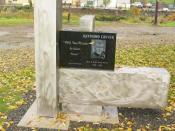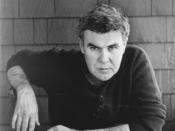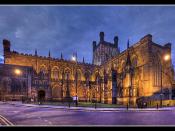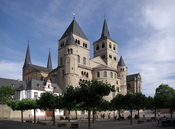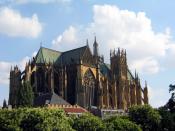Contrasting Imagery with Symbolism
The story The Cathedral by Raymond Carver is a story of transformation of a human character's life from depression and carelessness to belief and diversity. A cathedral is a symbol of faith, conversion, creativity and strength and is therefore a substantial component of Carver's story. The process of drawing it becomes the climax of the story when the author uses intense imagery to describe the workings of the drawing that the husband is creating. Imagery and symbolism are greatly used in this story, but in very different ways to provide very different effects. Moreover, the cathedral is connected to the representation of the blind man as a preacher and a teacher. The symbolism of the cathedral in the story makes one believe in the future and optimism.
A cathedral symbolizes religion, and the TV show that the two men watch leads to an important question. The blind man asks the husband to describe to him the image of a cathedral.
The husband is unable to successfully compose an accurate description because he doesn't understand the meaning and the symbolism of the building. He is not a man of religion, and he is watching the show only because he has nothing else to do. "Don't ask me why this is,"(245) he says. Compelled to think about the purpose of cathedrals, the narrator begins to realize that they symbolize the struggle that people endeavored to build those structures. What would make people do such a thing? Belief and religion sometimes give direction and meaning to peoples' lives. The effort required to build a cathedral becomes an outburst of creativity. The inability of the husband to understand the purpose of cathedrals shows that he lacks creativity, and his life is meaningless and not fulfilling.
By making the husband draw a cathedral together with him, the blind man teaches him about the importance of the cathedrals and the significance of believing in something. The husband experiences something that he has never thought would happen to him, and it makes him aware of the diversity of life. Before Robert came, the husband was alone, and his wife says that he didn't have other friends. "Never thought anything like this could happen in your lifetime, did you, bub?" asks Robert and there is no answer. The narrator's loneliness caused by urban life has become his style of living, and when he has to communicate with others and to share ideas he becomes anxious. The detachment makes him pessimistic and closed-minded.
The narrator's anxiety disappears as the story progresses, and when he begins to draw he is more relaxed and in a creative mood. The first thing that he thinks of is his house: "I drew a box that looked like my house"(247). The transformation of the house into a cathedral is a very powerful image. His home and himself derive the symbolism of a cathedral. And "What's a cathedral without people?"(247). Characterized as a social place where people meet, the cathedral becomes symbol of the husband's ability to overcome his loneliness and his inability to communicate.
The author uses suddenly uses intense imagery in the story that he hasn't used before, this is to emphasize the importance of the moment. "His fingers rode my fingers as my hand flowed over the paper. It was like nothing that I have ever felt before."(247) This marks the climax of the story as well as the turning point in the thoughts and beliefs of the husband. Nevertheless, the husband doesn't change his life by himself. It seems that the blind man is showing the husband how to draw and not the opposite. Robert is in control, but the narrator does not oppose that experience. He has been waiting for something like this to happen, and he is happy that it happened. The process of drawing a cathedral together with the blind man creates the symbolism of a cathedral and becomes a religious experience, which symbolizes the husbands conversion - his spiritual epiphany from good to bad. He is taught the meaning of value and virtue; he is happy that he encountered Robert.
The symbolism of the cathedral is also directly connected to the blind man. His question if the husband is a religious person is almost rhetorical because he already knows that he isn't. The blind man is a very powerful person because his blindness has made his other senses different than ours in a wonderful way. He sees things from a special perspective, and becomes a person who can share a different angle toward wisdom, a different entrance toward knowledge. For the husband, Robert comes as nobody, and he becomes somebody. He is like a preacher who opens your mind and gives a meaning to life. The blind man is a teacher, and his image is connected to the spiritual image of a cathedral.
The image of a cathedral is an image of something enormously strong, stable and at the same time beautiful and creatively artistic. The author uses imagery not only to create a mental portrait of the physical surroundings of the story, but also to breath life into the symbolism of the images that are created. The small amount of imagery that is used is very significant in that the imagery that is used, brings across very strong and clear pictures of meaning and thought. The symbolism that is in this story is enormous. It can be found everywhere. It is used in contrast with imagery to give greater meaning to the story that otherwise wouldn't have been clear.
